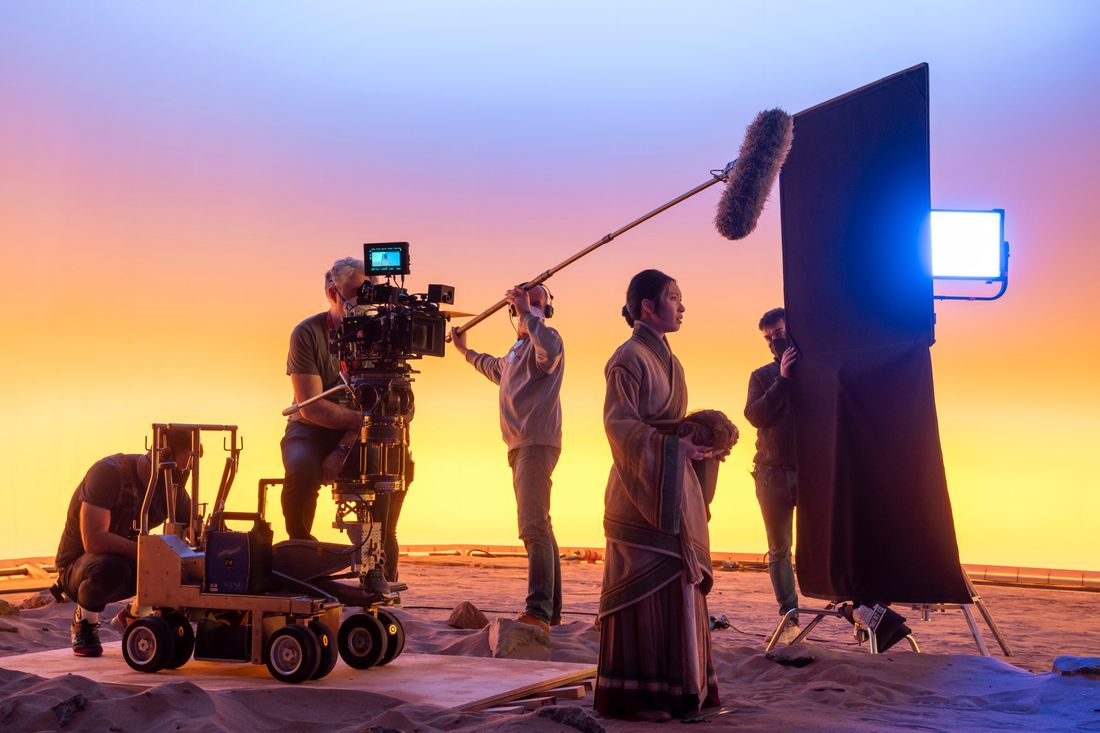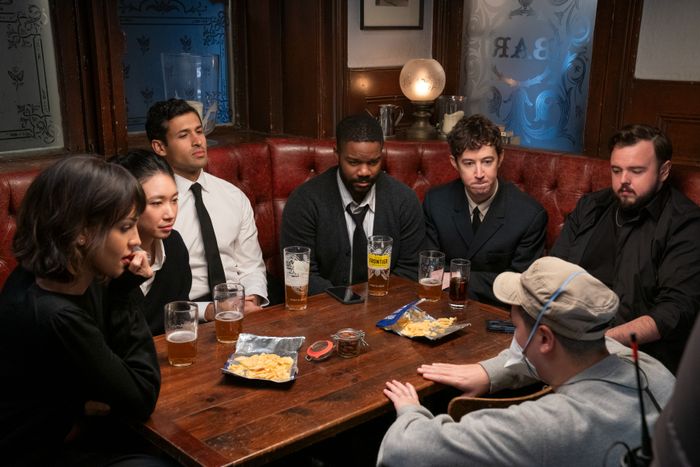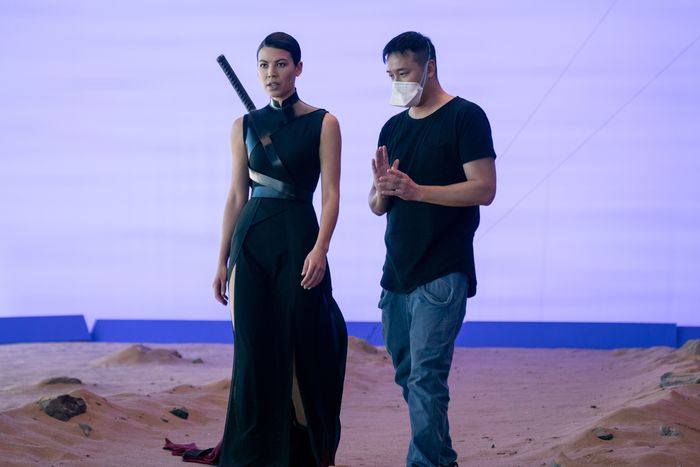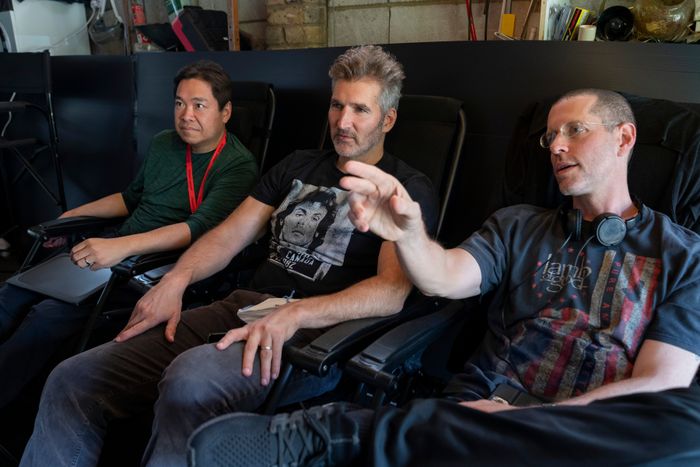
Spoilers follow for all eight episodes of 3 Body Problem on Netflix.
The secret to condensing a galaxy- and dimension-spanning sci-fi series into watchable television? According to David Benioff, lots and lots of Zoom calls. “The more exciting a sequence is on film,” he jokes, “the more hours of boring meetings.” Benioff, along with his Game of Thrones partner D.B. Weiss and The Terror: Infamy’s Alexander Woo, spent many hours in video conferences mapping out an English-language version of Cixin Liu’s seemingly unadaptable Remembrance of Earth’s Past sci-fi series. The books imagine a scientist making contact with an alien race, the San-Ti, who set their sights on invading Earth, with various factions of humanity intent on supporting or stopping them. If that’s not enough scale to envision, in the first book (called The Three Body Problem), there are descriptions of an advanced VR video game, the process of unfolding a proton into other dimensions, and a climactic action sequence in the middle of the Panama Canal. The show makes several big changes from the novels, notably moving the action from Beijing to London and introducing a cohort of young scientists as the main characters, but in many other cases it remains remarkably true to Liu’s vision, especially in those big action set pieces. Over a long, nitty-gritty video call of our own, Vulture spoke with Benioff, Weiss, and Woo about what they changed from the novels, what they felt they needed to keep, and how they plan to keep expanding the story.
One of the biggest changes from the book series is having a collection of young scientists, the “Oxford Five,” investigating what’s going on, rather than framing it around one character, Wang Miao.
Alexander Woo: We were pulling some of the lead characters of books two and three into season one, because we all write from character. If we’re going to engage with the characters, we might as well do it from the very beginning rather than go two seasons in and meet a totally new lead character. The leads of the various books don’t really intersect with one another, even though they exist contemporaneously. We made the decision early on to have those characters know each other, care about each other, be in conflict or in love with one another, and that was the genesis of the Oxford Five. When all the crazy stuff starts to happen, it’s happening to people you have some feelings toward, and that makes it much more emotionally effective than if it’s just whiz-bang visual effects.
D.B. Weiss: We knew that the Jin character doesn’t appear until book three, but a lot of the stuff she has to do in book three starts in the contemporary chronology. In the first book, the character on whom Auggie is based is male and is the person experiencing both what Auggie’s experiencing and the game experience. It felt like they could be safely uncoupled in a way that would make sense. Then you killed two birds with one stone: You gave Jin something substantive to be a part of early on, and you also clarified what was happening with the countdown versus what was happening with the video game.
The Jack character is a very, very minor character in book three, a person who is inspired by Will to create a soda drink of some kind. We decided, let’s make that character into Will’s oldest friend. Then we based Jack’s personality on John Bradley as we know him in life, because this character has a fair bit to do as he exists in this world and nothing at all to do with John’s previous onscreen persona. We knew Will had to buy the star. We knew he had to get the money to do that from somewhere, and we made the source of that money a really fun outlier presence of the Oxford Five.
I’m curious about choosing London as the primary location for the events of your adaptation. Why there?
David Benioff: Well, it’s not Beijing because the contract always stipulated this was the English-language adaptation. The Chinese-language one does take place in Beijing. We were allowed to have enough Chinese to do the period scenes that are set there, but the show had to be predominantly English, so we knew it had to be somewhere outside of China. The decision to make it in England was in large part because of practical considerations: Dan and I worked in the U.K. for a long time. We had a crew we loved working with, so the temptation to bring back a lot of the people we danced with before was very hard to resist. Plus, there’s our casting director, Nina Gold, and great local acting there. We had talked about a couple of other potential universities where they could have met, but it was pretty early on that we settled on England.
Woo: Now that you mention it, there’s something nice about how London is gloomy. If it was happening at Caltech, everything would be warm. It wouldn’t feel quite the same. I think the mood, shooting it in the U.K., actually helped a lot.
It changes the cultural and political aspects of the story in an interesting way, setting it in this old Western colonial hub.
Benioff: London also feels like such a global city. We made the decision early on to make it feel like a truly global show. It’s set in England, but most of the characters are not English. London attracts immigrants from all over the world because there are a lot of opportunities.
In this setting, you connect things back to the Cultural Revolution through Ye Wenjie in a different way, too. Having the contemporary scenes somewhere else makes the show less about contemporary China, as the books are. And you give Ye a more personal relationship to the younger characters. Her daughter, Vera, is a scientist who dies by suicide, and Ye is a sort of mother figure to Jin.
Woo: In the novels, very few characters really know Ye. So when she’s revealed to be the head of the organization, it’s a surprise to the reader, but with the TV series, you engage with the characters. It’s hugely important to have Jin there so that you see the shock on her face. It means something because this is a character we’ve established a relationship with. She was orphaned, she had no family — Ye was her family in England. Obviously, moving it to a different country means something different. Now, Ye’s not a person who has persevered and is succeeding in the People’s Republic of China. She is an immigrant. That is a theme we were able to play out that doesn’t appear as much in the novels. Everyone in our story has emigrated to London. They are coming from somewhere else. Even the actual Brits come from working-class Manchester. Wade is coming from Ireland. We managed to craft a different story to take advantage of the setting we were in.
Early on, you must have had to think about how to adapt scenes inside the video game. What were those conversations like?
Benioff: In the books, the game sequences are piggybacking on an imagined near-future consumer product. It’s like a full-body Oculus Rift situation. We immediately knew we didn’t want to do that because it was hard picturing that visually. We had a much easier time picturing a really striking graphic headset. When Jess Hong puts the thing on her head and her hands slowly lower this menacing object onto her face, that’s visual. Somebody getting into a giant techno garbage bag would not be nearly as exciting.
We looked into the possibility of rendering the game with photo-real animation. Love, Death & Robots has done some amazing stuff there, but the problem was that it exists already and has the shock of the hyperreal associated with it. We thought we could explain what this alien civilization is capable of by presenting it not just as an immersive environment but as a direct neural interface that looks indistinguishable from reality.
Once we settled on that, we thought about how to light for three suns in the moments when there are two or three suns in the sky at the same time. With the help of Jonathan Freeman, our really brilliant lead cinematographer, we turned the entire soundstage into a low-res LED volume. We’re not projecting anything you see in camera, but we’ve got the ability to do very subtle lighting changes, 360 degrees in a very large space. Then, the rest of it is the actual images, working with Steve Colbeck and Stefen Fangmeier, our VFX team, to come up with things that looked and felt like they were a real world, just not our world.
Woo: We iterated the San-Ti dehydrating and rehydrating several times. When you read it, it creeps you out, and it was a challenge throughout the entire process to visualize things that people are going to have already imagined and remembered. It had to look as good or better than what you were imagining when you read it.
In your version, you refer to the aliens as the “San-Ti,” which is the Mandarin phrase in the books, not the standard English translation of “Trisolaran.” Why go with San-Ti?
Benioff: Honestly, it sounded better to us. It was just a taste decision. Trisolaran sounded goofy. There was something nicely ominous about San-Ti, as long as it doesn’t sound too much like “Santy Clause.”
Weiss: It’s funny, because on the page, Trisolaran looks fine. But people are going to be saying this over and over again, and it didn’t sound quite as good as we wanted it to.
Woo: The original Chinese is “San-Ti Ren,” so that was in some ways even closer to the original.
In the game, you introduce the figure of the Sophon, played by Sea Shimooka, as this intimidating yet alluring woman who walks out at the end of every level. That’s a creation that figures more into the later books and is also very hard to imagine onscreen. What went into conceptualizing her?
Benioff: I have a video from when I was going into a parking garage beneath a building a few months ago, and the voice of the machine saying “Please put in your ticket” sounded so much like the voice Sea does. It really freaked me out! That character — even calling Sophon a character is strange — but that presence becomes very important and we really wanted her/it on the board early on. Rather than having a disembodied voice for these scenes, we wanted someone we could actually look at and see.
Weiss: Getting the design right on her costume was one of the trickier things we did. It needed to strike a balance between alluring and menacing, and it needed to be terrifying in the right lighting and the right circumstances. Michael Wilkinson, our costume designer, was more than equal to that challenge. Some of the earlier concept versions seemed a little too florid, a little too much like something in a video game or really cool fantasy art. Knowing from experience how that can translate, big things that float ethereally end up being a bunch of fabric that hangs like a dead squid on somebody’s back. She needed to have clean lines. Even her hair is very austere and severe and slicked down.
And her voice becomes crucial in those conversations with Jonathan Pryce’s Mike Evans, which you use to get across a lot of exposition about the San-Ti early on.
Weiss: That conversation was always one of the main draws for us, one of the main things that set this apart from other science-fiction shows, because it’s such a chilling, creepy slow burn — almost like a David Lynch feeling — than any straight-ahead science-fiction feeling. In the book, those scenes are not actually a conversation but a dossier of information. Once we decided to turn it into a scene between Jonathan and Sea’s voice, we were really, really excited to see Jonathan actually perform it with Sea crouched in the corner underneath the camera where he couldn’t see her.
Benioff: I’m pretty sure that scene doesn’t happen until the second book. There were a few scenes in the later books where it felt like Liu thought of something great, but the first book had already been published, so he couldn’t put it in the first book. If he had to do it all over again, maybe he would’ve put that scene in the first book when Evans was still alive, not after he dies.
When we were trying to recruit Jonathan for this, Dan and I were walking through Hyde Park. We got him on the line and we said, “There’s a scene in there that almost feels like Krapp’s Last Tape, because it’s basically just you sitting at a desk talking. There is another voice coming, but there’s no one else that we see. It’s almost a monologue and it’s all you.”
Weiss: After he pitched that scene to Jonathan, he took a breath and he said, “Well, you haven’t given me any reason to say no.” With a sigh of resignation, he agreed to work with us again.
Benioff: Then he had to run down corridors when he’d just had hip surgery.
Let’s talk about the Panama Canal set piece, which is in the books, and a huge visual moment in episode five. There’s a real eeriness to watching invisible strings cut through a tanker.
Benioff: This one was just endless meetings. At first we thought maybe we would use a real oil tanker and cut it with VFX, but that proved too expensive. We looked into traveling to Panama. For obvious reasons, the Panama Canal Authority was not too excited about the prospect of having us film a tragic accident there. Or using it at all. So it’s a huge VFX sequence. And a lot of the credit, obviously, goes to the VFX team led by Steve Colbeck, and also to Minkie Spiro, the director. The amount of time she spent on the sequence … I wish she had a counter for it. I wish there was that iPhone app that instead of steps walked, it was minutes spent on this.
But I’ll always remember: We’d have these endless walks with her down the ship’s corridors that Deb Riley designed, and we had these little LED light strips on the floor that would mark off how fast the wires were going. She was working with the props team and the VFX team. Some of the things are being cut practically, but a lot of it is being cut by VFX.
A big challenge in a story that depends on a lot of theoretical concepts is making sure the audience is with you when things get heady. I thought it was clever, for instance, to slip in a discussion of multidimensional thinking relatively early on, in a conversation about flatbread at a dinner table. How did you think about making sure everyone had a basic grasp of the science?
Weiss: It’s a question of balance. On the one hand, you don’t want to withhold the notion of more dimensions, and you don’t want to withhold it until the five minutes before you really need it down the road. On the other hand, you don’t want to give somebody a 20-minute lecture about extra dimensions long before it comes into play.
It was really about getting the idea out there and attaching it to a feeling — with the help of the great visual-effects work of Steve and Stefen and the whole team — that there’s something so far beyond our abilities it’s almost magical. The combination of a mundane introduction at the dinner table and a more magical introduction in the game, we wanted to put it on the table that extra dimensions are a piece we’re playing with. Down the line, it’s going to become more important — it’s going to become one of the most important pieces on the board — but not yet.
Woo: We had two science advisers in particular, Dr. Matt McKenzie, who’s a particle physicist — part of the team that discovered the Higgs Boson, so he’s the real deal — and Bobak Ferdowsi, who is a JPL and a real-life rocket scientist. They gave us and the cast little Cliffs Notes on physics 101. But the way they communicated difficult, complex concepts to a layman in a way you could absorb in real time was just as important. In a book, you can read it at your own pace and you can look things up if you want to. When you’re experiencing a television series, you want the whole thing to flow in front of you, and that means these complex ideas need to be digestible in real time regardless of who’s watching. We got as much from the way Matt and Bobak conveyed these ideas as we did the content of what they conveyed.
Benioff: It was Matt, or maybe it was a friend of Matt’s, who came up with the idea of Vera Ye jumping into the Cherenkov tank in the particle accelerator. In the book, it’s a slightly different suicide. We were looking for something highly visual that would take place in and around the environment of an accelerator.
Streaming TV shows can be infamous for their tendency to take their time setting up a premise, but 3 Body Problem burns through plot very quickly. Was it a conscious decision to keep the pacing quick?
Weiss: A lot of it comes down to knowing what it takes to produce a show at a certain level of intensity, and what it takes to make something look the way it needs to look and feel the way it needs to feel. If you’re going to make it beat for beat, chapter and verse, there’s no way to do it in less than five years for an outrageous amount of money. More important than that, it was about needing to feel a sense of urgency and propulsion. Eight episodes always felt right to us, at least for this season. It’s not a superfast burn. It takes some time for people to understand, for all the threads to come together, the video game and the countdown and the suicide-slash-murder investigations. Taking 10 or 20 episodes to answer that question didn’t feel viable for the kind of show we were making.
You’ve said in other interviews that you have an imagined four-season structure for this show, should you be able to make more of it. How much of the future of the series have you plotted out?
Weiss: We’ve done a good amount of work on the second season. At this point, the shape of it is pretty detailed in terms of character journeys and who lives, who dies, who goes where, how things function. The rest of it … there are three books, so that seems to suggest three seasons. The third book is very long, which might suggest more than three seasons, but we’ve already used a fair amount of the third book. It’s hard to know until you get there.
I really liked the first book. But books two and three I loved. There was stuff — the video game and the cultural revolution and the Panama Canal — that we knew we needed to put on the screen. As the story goes on, those things increase both in number and just what the fuck? intensity. There are more of those things in the second book than the first, and much more in the third book than the second. If we do justice to those things onscreen, by the time you get to the last season or two of the show, we would be giving people an experience they’ve never had before. We’re very hopeful we can get there, because it just gets wilder and wilder as you go. The three of us would love to tell the story to its glorious culmination.
This interview has been edited and condensed.
More From ‘3 Body Problem’
- The Best TV Valleys of 2024
- 3 Body Problem Is Not Afraid to Be TV
- 3 Body Problem? More Like Two More Seasons





